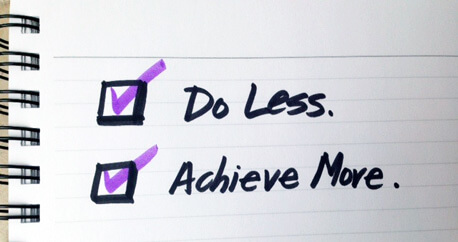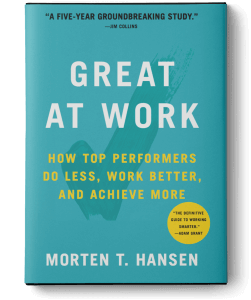{latest in the weekly series on Smashing Paradigms}
For my story-telling explanation of the definition of a Paradigm, see “What is a Paradigm“.
One way of defining a paradigm is “an unconsciously held belief that limits us from fresh thinking” or “we’ve always done it this way”

(c) smasherofficial.com

Do less, achieve more.
Yeah, yeah, I hear some say, we’ve all heard about work smarter, not harder.
First a few thoughts from me and a live example of why to do this, then some tips from Professor Morten Hansen from the in depth research he undertook for his new book “Great at Work”.
In a past “Smashing Paradigms” article “Stop the “Busyness” “, I wrote :
As a coach to leaders around the world, and in particular with CEOs, I constantly find themes to work with them on that include one or more of :
- Elevating their context to work ON the business, not IN the business
- Be the “Keeper of the Vision”
- Manage the Energy (for themselves and for their business)
- Be clear on their personal WHY
- Be a leader, don’t Do leadership
Put simply, for leaders, less is more. Simple, yes ? But how many of you just skipped over this and then skipped to thinking: “I get that, but I have so much to do, I’m so BUSY !”
As the saying goes, “If I had a dollar for every time I heard that” !
So why be less busy ? why do less ?
A live example. As I write this article , I just had a call from a client who called to tell me they had just agreed a life changing deal around their business. A huge decision that has them feeling “awesome” and at the same time “tranquil” and with “clarity”.
Sometimes “Do Less” simply takes committing some time to being focussed on the big picture, to work “on the business, not in the business” for part of your time. Also to focus on what really matters to you as a person, as the two are oft intertwined.
The two of us meet at the start of the day once every two weeks and have done for quite some time. That’s all. A couple of hours every two weeks. Simply taking that small amount of time enabled this business leader to shift their focus to conceive of a strategic move that would they would never have considered prior to creating that space for themselves.
So, those are some thoughts from me and a live example, now the new book.

First, what a great reference at the top from Jim Collins, author of “Good to Great“.
(Before I go further, if you have not read that book, please do so, now ! Good to Great is essential reading for any business or organisational leader.)
Jim Collins notes “a five year ground-breaking study”. I love it. I love when academics do accurate research then write about their findings, saves me a lot of work ! Thank you Morten Hansen (and Adam Grant, Carol Dweck and many more!).
There is a lot of wonderful findings distilled into tips in the book. I’ll highlight three here.
- Match Purpose and Passion
- Work Smarter
- Do Less, Then Obsess
Match Purpose and Passion
Morten Hansen :
“People who are really passionate about their work, but have no sense of purpose, perform at decent levels compared to top performers who have matched purpose and passion”
Agreed, and happy to see research back it up ! Purpose beats Passion. Purpose is sustainable, passion matching to purpose creates momentum and energy.
Feels like a personal extension of the famous Peter Drucker line for business : “Culture eats strategy for breakfast”
Work smarter
Yup, back to that. Hansen’s study finds that yes, one must work hard to thrive.. up to a point. He suggests 30-50 hours as a range. However, he clearly finds that working beyond 50 hours creates radically diminishing returns.
Morten Hansen : “Why do medical interns work 24 hours straight, when that’s not the best way of adding value? Why do McKinsey consultants work 70 to 80 hours a week instead of 50, even though the data shows that tacking on that many hours actually diminishes performance?”
Think about that for a minute. That Doctor has your life in their hands. That consultant you pay a lot of money and put your trust in around key decisions. If you have a coach for example, ask the how many clients they see each day ? This tells you a lot about their energy and how they manage themselves so as to be of value to you as their client.
Back to Hansen’s book, where he has seven “work smarter” practices he has derived from his studies. For me, over my years of experience I’ve learned many such practices.
Here is one for you of my own. Do not send any emails outside of working hours. Simple, but feels radical to some, yes ?
If you receive an email after working hours and feel you want to review it and reply to clear your own mind, your own energy, then write the reply, but do NOT send it. Instead, save it in your draft folder and send at the start of the next day. Oh, research also shows people are sharper and more receptive to emails in the morning too !
Try it, you’ll be amazed of the impact. Your own energy and wellbeing will improve, and very soon your clients and colleagues will adapt and flow.
Do Less, Then Obsess !
Link to a short clip (which will open on a new page) on Dan Pink interviewing Morten Hansen, with one tip on “Do Less, then Obsess” Pinkcast 2.13. How to be great at work: Do less and obsess | Daniel H. Pink
In this short clip, Morten Hansen breaks this into two levels :
- Go all in on 1 or 2, maximum 3 things
- Obsess about them, be fanatical in your attention to them.
Anyone who works with me knows that I love to distil down to three things. The one thing I’d add is to set a Context that sits over and gives a “WHY” to those three “WHATs”
In closing, then, how do you feel having read all of this ? Could you “Do Less, yet Achieve More” ?
